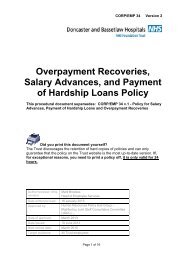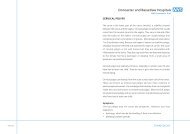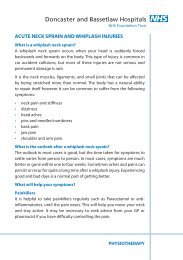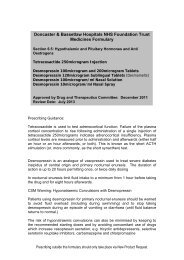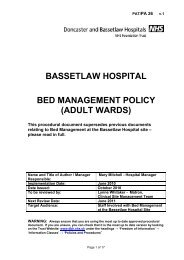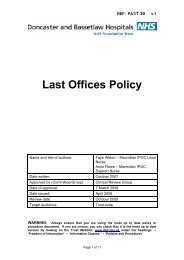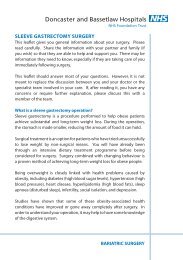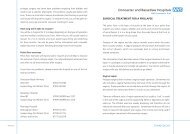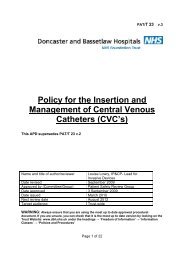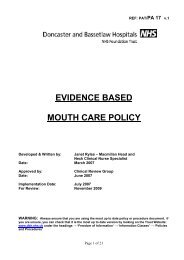VARIANT CREUTZFELDT-JAKOB DISEASE (vCJD) AND ...
VARIANT CREUTZFELDT-JAKOB DISEASE (vCJD) AND ...
VARIANT CREUTZFELDT-JAKOB DISEASE (vCJD) AND ...
You also want an ePaper? Increase the reach of your titles
YUMPU automatically turns print PDFs into web optimized ePapers that Google loves.
PAT/IC 4 v.3<br />
Table 3. Actions to be taken following patient’s response to questions in Table 2<br />
Patient’s<br />
response<br />
No to all<br />
questions<br />
Yes to any<br />
of questions<br />
1,2 or 3<br />
Action<br />
Surgery or neuro-endoscopy can proceed using normal infection control<br />
procedures<br />
Further investigation should be undertaken to assess the nature of the<br />
patient’s CJD risk – and this assessment recorded in the patient’s notes.<br />
If the patient is found to be at increased risk of CJD or<strong>vCJD</strong>, or the risk<br />
status is unknown, special infection control precautions should be taken,<br />
including quarantining of instruments (see below) and the Infection<br />
Prevention and Control team consulted for advice.<br />
Also see “Transmissible spongiform encephalopathy agents : Safe working<br />
and the prevention of infection” - Annex J. Department of Health for further<br />
advice<br />
Yes to<br />
question 4<br />
A highly transfused <strong>vCJD</strong> risk assessment form (see “Transmissible<br />
spongiform encephalopathy agents : Safe working and the prevention of<br />
infection” - Annex J Appendix D. ) should be completed if<br />
• The patient has received more than 50 units of blood or blood<br />
components or<br />
• The patient has received blood or blood components on more than 20<br />
occasions<br />
The results of the risk assessment, including the number of transfusions to<br />
date, should be recorded in the patient’s medical notes.<br />
If the patient has received fewer than 80 donor exposures, the patient is<br />
not considered to be at increased risk of <strong>vCJD</strong>. Surgery or neuro-endoscopy<br />
can proceed using normal infection control procedures.<br />
If the patient has received 80 or more donor exposures, the patient is<br />
confirmed as “at increased risk” of <strong>vCJD</strong>. Special infection control<br />
precautions should be taken, including quarantining of instruments (see<br />
below) and the Infection Prevention and Control team consulted for advice.<br />
The highly transfused <strong>vCJD</strong> risk assessment form should be forwarded to<br />
the HPA CJD section.<br />
For further advice and guidance see “Transmissible spongiform<br />
encephalopathy agents : Safe working and the prevention of infection” -<br />
Annex J. Department of Health and Pre-surgical assessment for <strong>vCJD</strong> risk<br />
in neurosurgery and eye surgery units. Information for clinicians. HPA 2009<br />
Unable to<br />
respond<br />
See section 10.1 part iii - above<br />
Page 13 of 22



